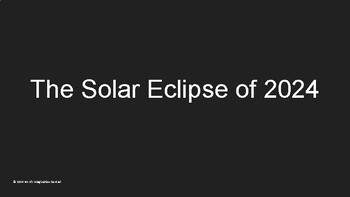Solar Eclipse 2024
Mr K's Imagination Central
6 Followers
Grade Levels
3rd - 8th
Subjects
Resource Type
Standards
NGSS5-ESS1-2
NGSS5-ESS1-1
NGSSMS-ESS1-2
NGSSMS-ESS1-1
Formats Included
- PDF
- Internet Activities
Pages
12 pages
Mr K's Imagination Central
6 Followers
Compatible with Digital Devices
The Teacher-Author has indicated that this resource can be used for device-based learning.
Description
This presentation is simply meant to help your intermediate learners understand a bit about the way our planet, moon, and sun interact to create events like day and night, the moon phases and larger events like the eclipse taking place on April 8th, 2024. It is intended to be informative in nature and to help learners explore parts of the solar system with great online resources I collected from the best sources.
Total Pages
12 pages
Answer Key
N/A
Teaching Duration
N/A
Last updated 2 months ago
Report this resource to TPT
Reported resources will be reviewed by our team. Report this resource to let us know if this resource violates TPT’s content guidelines.
Standards
to see state-specific standards (only available in the US).
NGSS5-ESS1-2
Represent data in graphical displays to reveal patterns of daily changes in length and direction of shadows, day and night, and the seasonal appearance of some stars in the night sky. Examples of patterns could include the position and motion of Earth with respect to the sun and selected stars that are visible only in particular months. Assessment does not include causes of seasons.
NGSS5-ESS1-1
Support an argument that differences in the apparent brightness of the sun compared to other stars is due to their relative distances from Earth. Assessment is limited to relative distances, not sizes, of stars. Assessment does not include other factors that affect apparent brightness (such as stellar masses, age, stage).
NGSSMS-ESS1-2
Develop and use a model to describe the role of gravity in the motions within galaxies and the solar system. Emphasis for the model is on gravity as the force that holds together the solar system and Milky Way galaxy and controls orbital motions within them. Examples of models can be physical (such as the analogy of distance along a football field or computer visualizations of elliptical orbits) or conceptual (such as mathematical proportions relative to the size of familiar objects such as students’ school or state). Assessment does not include Kepler’s Laws of orbital motion or the apparent retrograde motion of the planets as viewed from Earth.
NGSSMS-ESS1-1
Develop and use a model of the Earth-sun-moon system to describe the cyclic patterns of lunar phases, eclipses of the sun and moon, and seasons. Examples of models can be physical, graphical, or conceptual.




